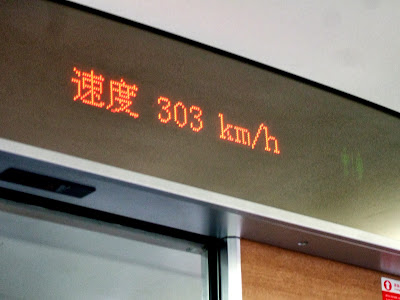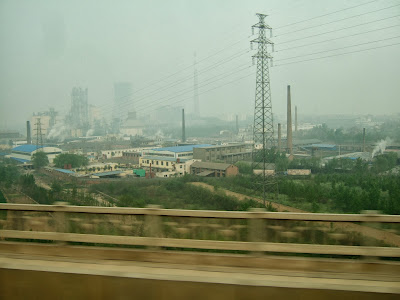G train at Hangzhou
Travel Date April 2012.
Click on any picture to see a large version.
Click on any picture to see a large version.
I have always enjoyed train travel. I
grew up travelling on country trains in New South Wales in the '50s
and '60s. Sadly, the Australian rural train system is slowly
disappearing, as I mention here in my rarely up-dated Australian
blog: Sentimental
Journey - a Lost Railway
On my overseas travels whenever time
and funds permit I choose to travel inter-city by train.
Consequently, over the past decade I have travelled by rail on
America's AMTRAK, from London to Oxford and Ipswich in the UK, the
Eurostar from London to Paris, a couple of TGVs in France and on several
inter-city trains in Switzerland, Italy, Croatia, Bosnia and Herzegovina,
Portugal, Spain and Morocco.
When planning my trip to China I spent
hours browsing through these web-sites studying their system and
learning how to buy tickets, which routes worked best for my itinerary and
comparing times to air routes.
Each is useful in slightly different ways; I used them all for planning. China Train Tickets includes a marvellous map which shows the vast extent of the Chinese active train system:
The system in China is massive. Unlike
much of the rest of the world they are expanding their system, not
letting it decay. There have been some teething troubles with the
speed of growth of the high-speed-rail system, but the results have
been spectacular in the past couple of decades.
Click on China Train Tickets to also see an
explanation of the different speeds and types designated by G, D, K
and other letters.
 |
| G train on-board speed indicator |
I found that in almost every case trains were faster and much more convenient than air. In two cases
air would have been faster: Suzhou to Beijing (5 hours by G
train) and Beijing to Xi'An (7 hours plus connections by G and D
trains via Zhengzhou). I considered the night train from Beijing to
Xi'An but decided against it because of the difficulty of obtaining a
two-person sleeper. My wife prefers privacy.
 |
| K train 'Welcome Aboard' at Shanghai |
 | |
| K Train Soft Sleeper Car |
 |
| K train 4-person compartment Soft Sleeper Berths |
 |
| K train six-person Hard Sleeper car. |
I still chose the train for both
routes. By the time I factored in airport security and cabs to and
from distant airports at both ends compared to a short ride to
Suzhou North and even shorter on arrival in Beijing South, the time and
money saving for Suzhou - Beijing was minimal. I paid first class on
the G train, which was almost the same as economy air-fare. The
saving in frustration and airport hassles was well worth it. For the
Beijing – Xi'An section there is now a high speed 5 1/2 hour G train direct,
but not then. Instead we decided to break the journey in Zhengzhou for a couple of nights to
see a non-tourist Chinese city. I'm glad we did.
 |
| K train end-of-car amenities. |
We only used air twice in China for our
internal travel. The various G, K and T train combinations would have taken too long from
Xi'An to Guilin. We tried to book the T101 sleeper from Hong Kong to
Shanghai, but could not get tickets. Instead I booked air using ctrip
from Hong Kong to Hangzhou and took the G train from there to Shanghai.
 |
| G train entering Suzhou North |
These were the trains we used on our
trip:
- Hangzhou – Shanghai G train 169 km 1:30 elapsed time.
- Shanghai – Suzhou K train 84 km 1:00
- Suzhou North – Beijing South G train 1237 km 5:10
- Beijing West - Zhengzhou D train 693 km 4:58
- Zhengzhou – Xi'An G train 505 km (miles) 2:05
We booked in two ways. For Hangzhou –
Shanghai and Zhengzhou – Xi'An I booked personally at the train
stations. For the others we used hotel concierge services for a very
small service fee.
The ticket offices in Hangzhou and
Zhengzhou stations are enormous. Zhengzhou, which is a major rail
hub, has four giant booking offices.
In Hangzhou I asked at the information
counter for directions to the English-speaking counter and joined the
long queue of sub-continental migrant workers at that counter. Look
for that queue in the absence of directions. The queue at Hangzhou
had about thirty in it when I arrived, but the progress was slowed by those at the front meekly letting queue-jumpers muscle in. I
finally reached the front myself and startled several queue-jumpers
by being less accommodating and pushing back. It seems they had not
had that reaction before. I got some dirty looks, but a cheer from
those behind and a smile from the lady at the counter. Unfortunately,
after giving her the details I discovered that I needed both
passports as a laowai to buy the tickets. I had to go outside,
collect her passport from my wife and rejoin the back of the queue. Thankfully
it was a little shorter second time around.
 |
| Booking Queue, Hangzhou |
 |
| Station Square, Zhengzhou |
You would think I'd learn. I did
exactly the same thing in Zhengzhou, but that time I had to return to
the hotel. At least it wasn't far from the station.
None of the stations had airport-style
security for luggage, although one (Beijing IIRC?) had standard metal
detectors at the entrance. I arrived about 30 minutes before travel
time, just to be careful. At the major stations all passengers wait
in large designated waiting rooms until the train arrives and the
passengers leaving the train are gone; only then are passengers
allowed on the platform to board the train.
 |
| Leaving the waiting room, Zhengzhou |
 | |
| G Train Suzhou - Beijing 1st Class |
 |
| G train at Zhengzhou |
All the trains were clean; most appeared almost brand new although the
K train was a bit shabbier generally. On board the G trains it was hard to believe
that we were travelling at over 300km/hr. The ride was smooth and quiet. There was almost no feeling
of acceleration or deceleration as we left and arrived at stations.
 |
| Taxi queue at Beijing |
After my experiences on the Chinese
train system I am rather sad that our politicians are still closing
some lines and debating whether we need a high speed rail at all in my
country.
I will close with some views from the window. One of the big differences between air and rail is that you see some of the country as you pass swiftly along.
 |
| Apartments Are Being Built Everywhere |
Cheers, Alan








Hello
ReplyDeleteIn addition to the websites you recommend, there still others great websites like http://www.chinahighlgihts.com/china-trains/, http://www.travelchinaguide.com/china-trains/ and http://www.seat61.com/China.htm. The first two are tour operators offering train ticket booking service and train travel guides. The last one is an expert from UK providing great tips on China train travel. You can go to visit them.